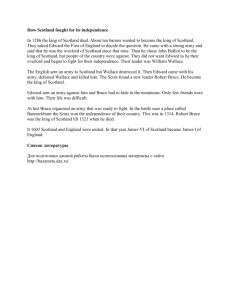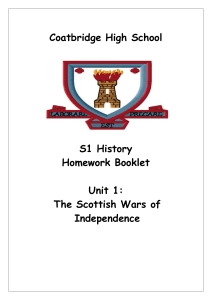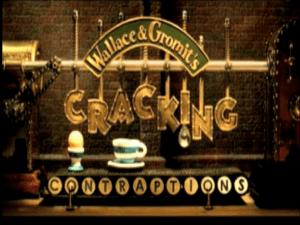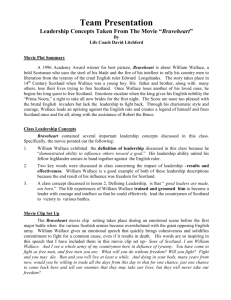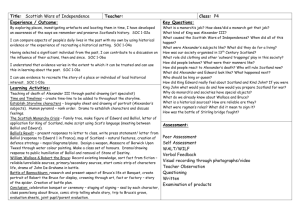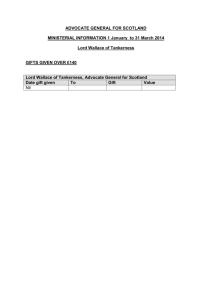Wallace and Bruce - Booklet 3
advertisement
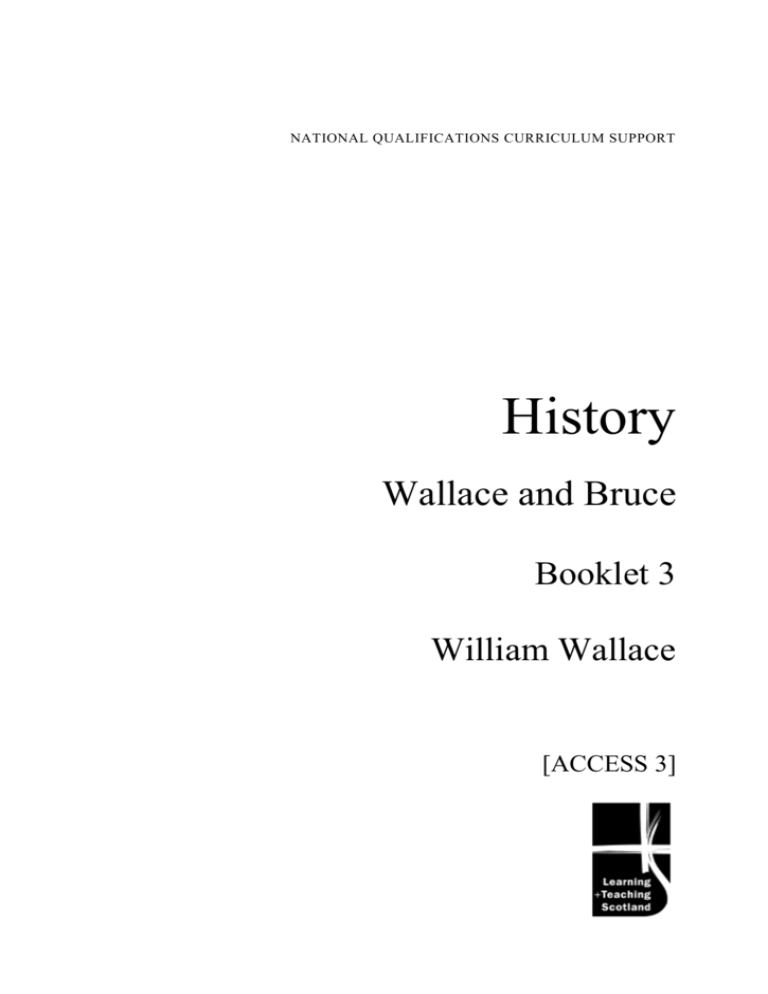
NATIONAL QUALIFICATIONS CURRICULUM SUPPORT History Wallace and Bruce Booklet 3 William Wallace [ACCESS 3] The Scottish Qualifications Authority regularly reviews the arrangements for National Qualifications. Users of all NQ support materials, whether published by Learning and Teaching Scotland or others, are reminded that it is their responsibility to check that the support materials correspond to the requirements of the current arrangements. Acknowledgement Learning and Teaching Scotland gratefully acknowledges this contribution to the National Qualifications support programme for History. © Learning and Teaching Scotland 2007 This resource may be reproduced in whole or in part for educational purposes by educational establishments in Scotland provided that no profit accrues at any stage. 2 WALLACE AND BRUCE (ACCESS 3, HISTORY) © Learning and Teaching Scotland 2007 Contents Introduction 4 Topic 1: Edward’s control over Scotland 5 Topic 2: Scottish revolts 8 Topic 3: Wallace’s revolt 10 Topic 4: Cressingham and King Edward’s government of Scotland 12 Topic 5: The Battle of Stirling Bridge, 1298 (a) Preparing for battle (b) The Battle of Stirling Bridge, 1298 13 13 16 Topic 6: William Wallace as Guardian of Scotland 22 Topic 7: The Battle of Falkirk, 1299 (a) Preparing for battle (b) What happened at the Battle of Falkirk, 1299 24 24 26 Topic 8: What happened after the Battle of Falkirk: 1299–1302 28 Scotland and England, 1302–05 30 Topic 9: WALLACE AND BRUCE (ACCESS 3, HISTORY) © Learning and Teaching Scotland 2007 3 INTRODUCTION Introduction What am I going to find out about? King Edward’s control over Scotland The Scottish revolts against King Edward Wallace’s revolt Cressingham and the Government of Scotland The Battle of Stirling Bridge, 1298 William Wallace as Guardian of Scotland The Battle of Falkirk, 1299 The results of the Battle of Falkirk Scotland and England, 1302–05. 4 WALLACE AND BRUCE (ACCESS 3, HISTORY) © Learning and Teaching Scotland 2007 EDWARD’S CONTROL OVER SCOTLAND Topic 1: Edward’s control over Scotland When King Edward left Scotland in 1296, he believed he had it under his control. King Edward wanted to make sure that all the Scottish nobles would obey him. This was important because the Scottish nobles owned land in Scotland and they were in charge of running the country. He thought they would obey him because of: Prison: John Balliol and many important nobles were his prisoners in England. They would tell their people to do exactly what King Edward wanted. Hostages: Edward had taken the sons of other Scottish nobles to England. This was to make sure that their fathers did exactly what Edward wanted. Promises of Loyalty: All the important people in Scotland had promised to obey King Edward and do exactly what he wanted. Castles: King Edward had taken over all the important castles in Scotland so he could control the country and make the people do what he wanted. Government: King Edward had chosen Englishmen to govern Scotland for him and do what he wanted. Church: King Edward wanted only Englishmen to have important jobs in the Scottish Church so they could tell the Scots to do what he wanted. WALLACE AND BRUCE (ACCESS 3, HISTORY) © Learning and Teaching Scotland 2007 5 EDWARD’S CONTROL OVER SCOTLAND Activities Explain how each of these would help King Edward to control Scotland. Prison Hostages Promises of Loyalty Castles Government 6 WALLACE AND BRUCE (ACCESS 3, HISTORY) © Learning and Teaching Scotland 2007 EDWARD’S CONTROL OVER SCOTLAND Church WALLACE AND BRUCE (ACCESS 3, HISTORY) © Learning and Teaching Scotland 2007 7 SCOTTISH REVOLTS Topic 2: Scottish Revolts Revolts against King Edward started soon after he left S cotland. These revolts were started by Scottish nobles who did not like King Edward. Duncan MacDougall led a revolt in the west of Scotland. He was a relation of the Comyns. Many of his relations were in jail in England. Andrew Moray led a revolt in Moray. His relatives were in jail in England. James Stewart attacked King Edward’s castles in Ayrshire and Galloway. King Edward had just let him out of jail! Many ordinary people supported these revolts. 8 WALLACE AND BRUCE (ACCESS 3, HISTORY) © Learning and Teaching Scotland 2007 SCOTTISH REVOLTS Activities Look back at your answers about how Edward planned to control Scotland (page 6). 1. Why should each of these leaders have supported King Edward? Duncan MacDougall Andrew Moray James Stewart 2. Do you think King Edward’s plan to control Scotland was a success? WALLACE AND BRUCE (ACCESS 3, HISTORY) © Learning and Teaching Scotland 2007 9 WALLACE’S REVOLT Topic 3: Wallace’s revolt William Wallace’s father was a knight from Elderslie near Glasgow. William Wallace was his second son. So, William Wallace was not an important man in Scotland. William Wallace at Lanark Some English soldiers killed William Wallace’s wife in Lanark. So Wallace went back there one night and killed the English sheriff. This made William Wallace famous. He quickly gathered followers to attack other English soldiers. After each attack Wallace’s men would disappeared so the English could not find them. Then they would meet together to attack somewhere else. This made it very difficult for the English. Wallace’s fame spread and he attracted more supporters. William Wallace and Ormsby William Wallace became even more famous when he attacked King Edward’s Chief Judge in Scotland just outside Perth. The Chief Judge had to run away leaving all the money he had taken from the Scots. Wallace gave it back to them! 10 WALLACE AND BRUCE (ACCESS 3, HISTORY) © Learning and Teaching Scotland 2007 WALLACE’S REVOLT Activities 1. Write down three reasons why William Wallace became famous. WALLACE AND BRUCE (ACCESS 3, HISTORY) © Learning and Teaching Scotland 2007 11 CRESSINGHAM AND KING EDWARD’S GOVERNMENT OF SCOTLAND Topic 4: Cressingham and King Edward’s government of Scotland King Edward had left Hugh Cressingham in charge of running Scotland. Cressingham made himself very unpopular in Scotland. He made the Scots pay him lots of money in taxes. The people thought they were being robbed! But after Wallace’s revolt, Cressingham found that he could not collect any money from Scotland. Cressingham then reported to King Edward that all his men were in Scotland were either dead, besieged in their castles or too frightened to do any work! Activities 1. Why did the Scots not like Cressingham? 2. Write down two reasons Cressingham’s men were not able to do any work in Scotland. 12 WALLACE AND BRUCE (ACCESS 3, HISTORY) © Learning and Teaching Scotland 2007 THE BATTLE OF STIRLING BRIDGE, 1298 Topic 5: The Battle of Stirling Bridge, 1298 5(a): Preparing for battle Cressingham decided to gather an army to fight William Wallace. He led this army from England and towards Stirling. Wallace William Wallace decided to fight Cressingham near Stirling. The two armies faced each other across the River Forth, close to Stirling Bridge. Wallace placed his army on the high ground at Abbey Craig. Cressingham His soldiers could look down on the English army on the other side of the river. This gave his soldiers an advantage. Cressingham’s army had a problem. The ground around them was very wet and boggy. The weight of their armour would make them stick in the mud! They would have to stay on the road where the ground was firm. This meant that Cressingham’s army would be spread out in a long thin line. WALLACE AND BRUCE (ACCESS 3, HISTORY) © Learning and Teaching Scotland 2007 13 THE BATTLE OF STIRLING BRIDGE, 1298 Cressingham’s army was very confident. They had 2,500 knights and 13,000 foot soldiers who had lots of fighting experience. They all had good weapons and wore armour or very strong protection. But this slowed them down. On the other hand, William Wallace had very few knights, only 500 horsemen and 9,500 foot soldiers who were not as experienced as the English. They did not wear the same amount of protection which meant they could move faster than the English and they could cross wet ground more easily. The Scots soldiers fought using long spears and daggers. Activities You are going to compare the two armies just before the Battle of Stirling Bridge. 1. Gather information in the following table Scots number of men number of knights experience of battles equipment position before the battle 14 WALLACE AND BRUCE (ACCESS 3, HISTORY) © Learning and Teaching Scotland 2007 English THE BATTLE OF STIRLING BRIDGE, 1298 2. Use the evidence you have gathered to complete this comparison diagram. Scottish advantages English advantages Scottish disadvantages English disadvantages 3. Which side do you think was most likely to win the battle? WALLACE AND BRUCE (ACCESS 3, HISTORY) © Learning and Teaching Scotland 2007 15 THE BATTLE OF STIRLING BRIDGE, 1298 5(b): The Battle of Stirling Bridge, 1298 Cressingham had a big problem. The Scots were on the other side of the River Forth. To get to them the English could either: cross the narrow bridge over the River Forth. It was so narrow that there was room for only two horsemen to cross side by side. It would take a long time to get his army across the river. walk up the river for a few miles to a ford where the river wa s shallow enough for all of his army to cross quickly. However, it would take some hours to reach the ford and get back to the battlefield. While they were doing this, Wallace could move his army away and avoid a battle. Cressingham was so impatient that he decided to use the bridge. Wallace waited until a good number of English had crossed the bridge. Then his army charged. Wallace’s plan was to capture the bridge. This would cut the English army into two parts. The Scots would then slaughter the English on their side of the bridge. The rest of the English would not be able to help.Wallace hoped that they would run away! 16 WALLACE AND BRUCE (ACCESS 3, HISTORY) © Learning and Teaching Scotland 2007 THE BATTLE OF STIRLING BRIDGE, 1298 Wallace’s plan worked! Most of the English who crossed the bridge were killed. Cressingham was killed. After the fighting was over, the Scots found Cressingham’s dead body. They took the skin from the body and used it to make souvenirs such as purses and sword sheaths. WALLACE AND BRUCE (ACCESS 3, HISTORY) © Learning and Teaching Scotland 2007 17 THE BATTLE OF STIRLING BRIDGE, 1298 Activities 1. Use the information you have read to complete this table. Cressingham’s choice – to use Stirling Bridge or not to use Stirling Bridge. Advantages of using the bridge Advantages of using the ford Disadvantages of using the bridge Disadvantages of using the ford 2. Did Cressingham make the correct choice? 18 WALLACE AND BRUCE (ACCESS 3, HISTORY) © Learning and Teaching Scotland 2007 THE BATTLE OF STIRLING BRIDGE, 1298 3. What happened at the Battle of Stirling Bridge? The following 10 sentences describe what happened at the battle of Stirling Bridge. They are in jumbled order. Put them in the correct order by writing a number (1–10) in the box beside the sentence. Cressingham was killed. Wallace sent his army to capture the bridge. The English soldiers could only cross the bridge two-by-two. The Scots slaughtered the English on their side of the bridge. Once they had crossed the bridge, Cressingham’s soldiers had to stay on the road. Wallace was waiting for Cressingham’s army on Abbey Craig. Cressingham decided to send his army across Stirling Bridge. Wallace waited until half of the English army had crossed. Cressingham approached Stirling Bridge with a very big army. The English army was cut in two. WALLACE AND BRUCE (ACCESS 3, HISTORY) © Learning and Teaching Scotland 2007 19 THE BATTLE OF STIRLING BRIDGE, 1298 Source A describes the Battle at Stirling Bridge Source A The Scots and English faced each other across the River Forth. Cressingham was so impatient to defeat the Scots that he made mistakes. Wallace was able to attack and to cut off the bridge. The English soldiers were weighed down by their armour and they were all killed. 4. Read Source A Give two reasons why the English were defeated at the Battle of Stirling Bridge. Intermediate 1 Extension 5. Write down another two reasons (not in Source A) why the English were defeated. 6. Read Source A Describe two things that happened at the Battle of Stirling Bridge. 20 WALLACE AND BRUCE (ACCESS 3, HISTORY) © Learning and Teaching Scotland 2007 THE BATTLE OF STIRLING BRIDGE, 1298 7. Describe another two things that happened at Stirling Bridge that are not in Source A. WALLACE AND BRUCE (ACCESS 3, HISTORY) © Learning and Teaching Scotland 2007 21 WILLIAM WALLACE, GUARDIAN OF SCOTLAND Topic 6: William Wallace, Guardian of Scotland After his victory at Stirling Bridge, William Wallace became the leader of Scotland. The Scots were so pleased with him that they made him a ‘knight’. He became known as Sir William Wallace. The Scots also made Wallace ‘Guardian of Scotland’. This meant that he was in charge of Scotland. His job was to defend Scotland from King Edward and to try to bring back King John Balliol. William Wallace had to organise a new army that would be big enough and good enough to fight against King Edward. He also wrote to traders in Germany to buy iron to make weapons. At that time Bishop Fraser, the most important churchman in Scotland, died. King Edward wanted an Englishman to be the next Bishop of St. Andrews. This would give King Edward control of the Scottish church. William Wallace made sure a Scotsman, Bishop Lamberton, got the job. In this way a Scotsman controlled the church in Scotland. Bishop Lamberton went to Rome to see the Pope. He persuaded the Pope to tell King Edward to let John Balliol out of jail. On his way home, Bishop Lamberton persuaded the French king to help the Scots as well. 22 WALLACE AND BRUCE (ACCESS 3, HISTORY) © Learning and Teaching Scotland 2007 WILLIAM WALLACE, GUARDIAN OF SCOTLAND Activities The importance of William Wallace Use the information on page 22 to complete this diagram about why Wallace became important after the Battle of Stirling Bridge. Wallace was given the title of … Wallace took over the government of Scotland and was called the … Wallace had to organise a new Scottish … Wallace had to defend Scotland from attack by… Wallace made Lamberton Bishop of St Andrews and he sent him to get help for Scotland from …………........................ and from ……………………. WALLACE AND BRUCE (ACCESS 3, HISTORY) © Learning and Teaching Scotland 2007 23 WILLIAM WALLACE, GUARDIAN OF SCOTLAND Topic 7: The Battle of Falkirk, 1299 7(a): Preparing for battle King Edward decided to bring his army to Scotland to defeat the Scots. He brought: 12,000 foot soldiers 2,000 knights enough food for all of them. William Wallace’s army was much smaller. He did not have many knights. William Wallace would have to choose a battlefield very carefully. He decided to fight King Edward near Falkirk in the centre of Scotland. Wallace placed his men on a hillside. There were trees behind his army and a loch in front of it. The ground round the loch was very marshy. This would make it difficult for King Edward. Wallace put his spearmen into four groups called ‘schiltrons’. The men stood in circles with their spears pointing outwards. They looked like a hedgehog! S = schiltron of spearmen B = bowmen 24 Wallace placed his bowmen between the schiltrons. His knights were behind them. WALLACE AND BRUCE (ACCESS 3, HISTORY) © Learning and Teaching Scotland 2007 WILLIAM WALLACE, GUARDIAN OF SCOTLAND 1. Read page 24 about preparing for the Battle of Falkirk carefully and then complete this paragraph using three of the words from the box below. King Edward came to Scotland with a __________ army. In comparison, Wallace’s army appeared to be very __________. Wallace did not have as many __________ as King Edward. Wallace had to choose his battlefield carefully. small 2. large knights schiltrons Read page 24 carefully and then put a ‘’ where the sentence is correct or ‘x’ where the sentence is wrong. Wallace wanted a loch in front of his army so his soldiers could wash. Wallace wanted a loch in front of his army to make it difficult to attack his army. Wallace placed his men in circles like hedgehogs called ‘schiltrons’. Wallace’s men had not shaved so they looked like hedgehogs called ‘schiltrons’. Wallace placed his men in four groups with the knights behind them. Wallace placed his knights in four groups with his men behind them. WALLACE AND BRUCE (ACCESS 3, HISTORY) © Learning and Teaching Scotland 2007 25 WILLIAM WALLACE, GUARDIAN OF SCOTLAND 7(b): What happened at the Battle of Falkirk, 1299 King Edward sent his knights round each side of the loch. The Scottish knights all ran away when the English knights moved forward towards them. The Scottish bowmen were killed easily because the knights were not there to protect them. The English knights could not break the schiltrons. The sharp spears of the schiltrons were a very good defence from horsemen. Many English horses were killed by the Scottish spears. Edward then changed his plans. He brought up his bowmen. They fired arrows into the schiltrons. The rings of spears were soon broken by the bowmen because the men in the schiltrons had no way of protecting themselves from the arrows. Then, King Edward sent his knights to attack the schiltrons again. This time they broke through and killed the Scottis h spearmen. Most Scots were killed because they found it very difficult to escape. King Edward had won the battle! 26 WALLACE AND BRUCE (ACCESS 3, HISTORY) © Learning and Teaching Scotland 2007 WILLIAM WALLACE, GUARDIAN OF SCOTLAND What happened and why Here are two lists. One is called ‘What happened’ and the other is called ‘because’. Read the two lists carefully and then put them into pairs by writing the same letter in a ‘What happened’ and a ‘because’ box. One pair has already been done. What happened A The battle happened The Scottish knights all ran away The Scottish bowmen were all killed At first, the English knights could not break the Scottish schiltrons Edward changed his way of attacking and the schiltrons were soon broken Many Scots were killed because A The English and Scottish armies were both at the same place The Scots could not escape. The English knights had moved towards the Scots. Scottish spearmen in the schiltrons could not protect themselves from arrows. The Scottish knights were not there to protect them. Schiltrons were a good defence against horsemen. WALLACE AND BRUCE (ACCESS 3, HISTORY) © Learning and Teaching Scotland 2007 27 WHAT HAPPENED AFTER THE BATTLE OF FALKIRK 1200–1302 Topic 8: What happened after the Battle of Falkirk: 1299–1302 William Wallace resigned as Guardian. He only got the job because he had won at Stirling Bridge. Now that he had lost, he had to resign. Scottish noblemen choose two important nobles, John Comyn and Robert Bruce to take over as Guardians. King Edward then lost control of most of Scotland. (a) King Edward had to leave Scotland immediately to continue his war against the French. (b) The Scots decided to avoid proper battles. They used surprise attacks and captured back many Scottish castles from King Edward such as Stirling Castle. (c) The Scots supported the Guardians against King Edward . In fact by 1302, the Guardians ruled most of Scotland in the name of King John. King Edward controlled very little land in Scotland. (d) The Scots got foreign help. The King of France helped the Scots by keeping King Edward fighting in France. King Edward was too busy there to pay much attention to Scotland. (e) The Pope helped the Scots by making King Edward set King John free but he was not allowed to return to Scotland. By the end of 1302 the Scots thought they were well on the way to being free from King Edward. 28 WALLACE AND BRUCE (ACCESS 3, HISTORY) © Learning and Teaching Scotland 2007 WHAT HAPPENED AFTER THE BATTLE OF FALKIRK 1200–1302 Activities Turning it round! After the battle of Falkirk, King Edward lost control of most o f Scotland. This was not just because the Scots were successful, but also because King Edward had other problems. Use the information on page 28 to complete this list of problems King Edward had. He had to leave Scotland The French war kept him busy The Pope upset his plans The Scots would not fight properly The Scots did not support him because … because … because … because … because … WALLACE AND BRUCE (ACCESS 3, HISTORY) © Learning and Teaching Scotland 2007 29 SCOTLAND AND ENGLAND 1302–05 Topic 9: Scotland and England, 1302–05 Things got worse for the Scots after 1302. Robert Bruce gave up being Guardian. Then he went back to supporting King Edward. He did not really want to see John Balliol back in Scotland as king. He really wanted to be king himself! The King of France was defeated in battle. He had to make peace with King Edward and could not support the Scots any more. Edward could concentrate on Scotland. The Pope fell out with the King of France. He then decided to support the King of England. So, he stopped supporting the Scots. King Edward returned to Scotland with a powerful army. The Scots could not fight him. Most of them surrendered to him. Edward reorganised the government of Scotland. This time he gave all the top jobs to Scots. He also promised not to make any ch anges in Scotland. Many Scots accepted this promise. William Wallace was captured and executed. He was taken to London where he was hanged, drawn and quartered. King Edward said this was his punishment for not obeying his king. William Wallace said that Edward was never his king! By the end of 1305 King Edward thought that he had finally taken over Scotland. 30 WALLACE AND BRUCE (ACCESS 3, HISTORY) © Learning and Teaching Scotland 2007 SCOTLAND AND ENGLAND 1302–05 Activities Turning it back again! By 1305, King Edward appeared to be back in control of Scotland. Use the information on page 30 to show how Edward regained control of Scotland. Robert Bruce changed sides The French were defeated in battle The Pope changed sides King Edward returned to Scotland Edward re-organised the government of Scotland. This helped Edward because … Bruce had been a Scottish Guardian and this left the Scots weaker. This helped Edward because … This helped Edward because … This helped Edward because … This helped Edward because … WALLACE AND BRUCE (ACCESS 3, HISTORY) © Learning and Teaching Scotland 2007 31

